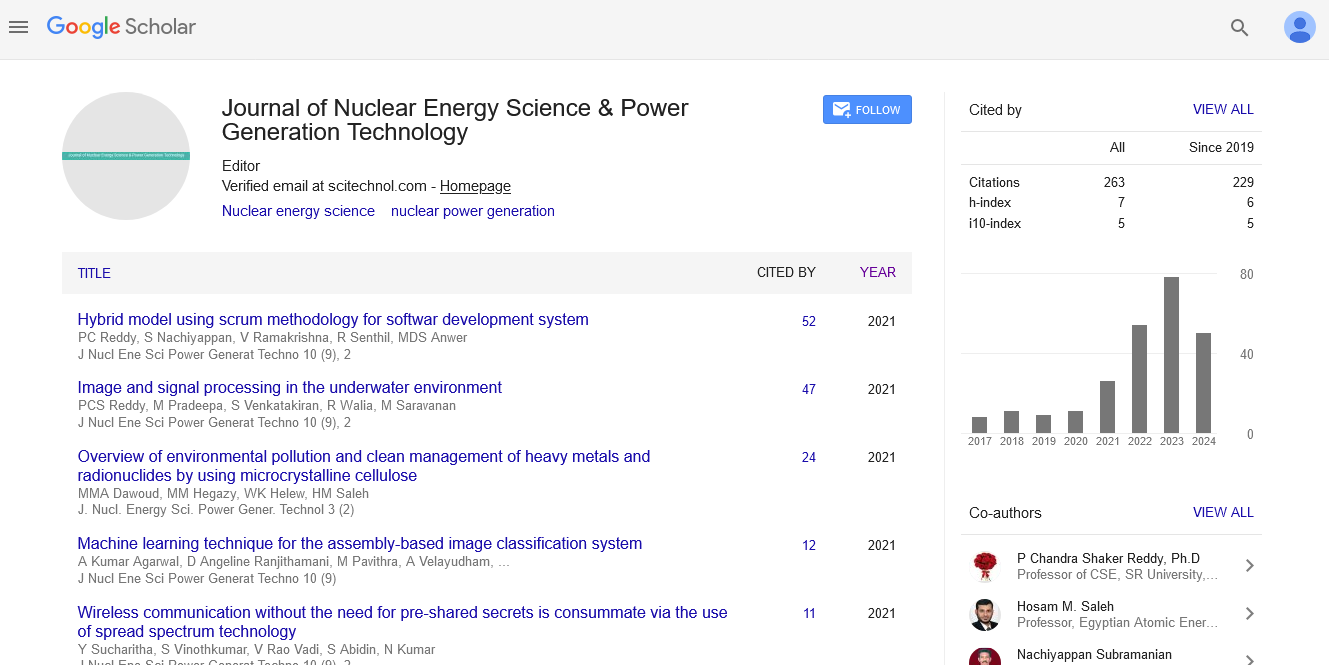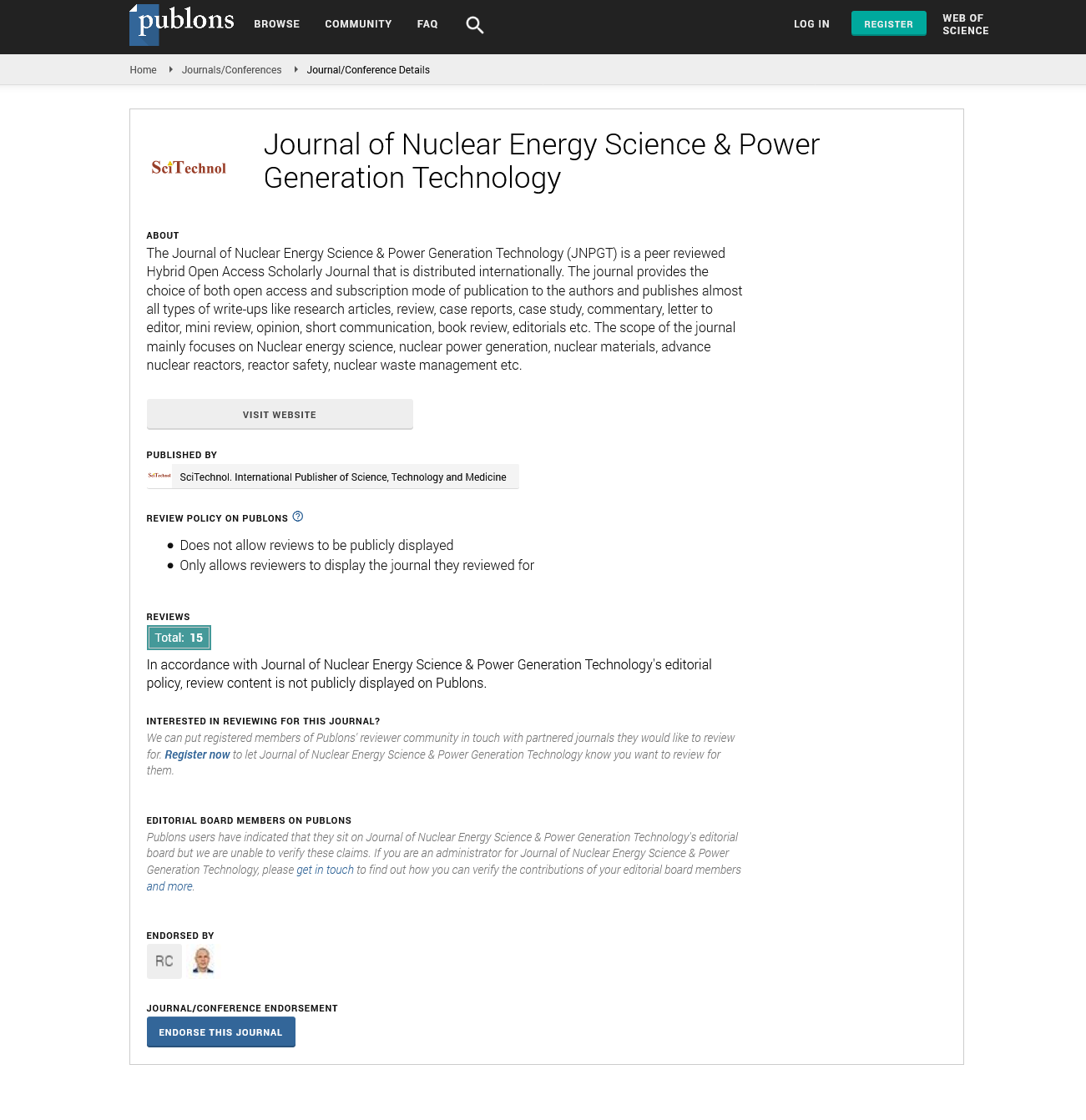Perspective, J Nucl Ene Sci Power Generat Technol Vol: 13 Issue: 4
Optimizing Neutron Economy in Heavy Water Reactors: Advances and Challenges
Danies Erin*
1Department of Power Production and Usage, National University for Science and Technology Politehnica of Bucharest, Bucharest, Romania
*Corresponding Author: Adamantia Nikolaidi, Oncology Clinic
Department of Power Production and Usage, National University for Science and
Technology Politehnica of Bucharest, Bucharest, Romania
E-mail: danies_erin123@gmail.com
Received date: 17 June, 2024, Manuscript No. JNPGT-24-143378;
Editor assigned date: 19 June, 2024, PreQC No. JNPGT-24-143378 (PQ);
Reviewed date: 03 July, 2024, QC No. JNPGT-24-143378;
Revised date: 11 July, 2024, Manuscript No. JNPGT-24-143378 (R);
Published date: 18 July, 2024, DOI: 10.4172/2325-9809.1000411.
Citation: Erin D (2024) Optimizing Neutron Economy in Heavy Water Reactors: Advances and Challenges. J Nucl Ene Sci Power Generat Technol 13:4.
Description
Heavy Water Reactors (HWRs) represent a class of nuclear reactors that use heavy water (deuterium oxide, D2O) as a neutron moderator and coolant. Distinguished from Light Water Reactors (LWRs), HWRs provide unique advantages, including the ability to use natural uranium as fuel and high neutron economy. This delves into the design, operation, advantages, and challenges associated with heavy water reactors. Heavy water reactors utilize heavy water to slow down neutrons, facilitating the nuclear fission process. The most common type of HWR is the CANada Deuterium Uranium (CANDU) reactor, which was developed in Canada. Heavy water serves a dual purpose. As a moderator, it slows down fast neutrons, increasing the likelihood of fission. As a coolant, it transfers the heat generated from fission to a secondary loop, where it produces steam to drive turbines. HWRs can use natural uranium, which is less enriched than the fuel required for LWRs. This is a significant advantage as it reduces the need for enrichment facilities and lowers fuel costs. Instead of a large pressure vessel, HWRs use an array of pressure tubes to contain the fuel and coolant. This design allows for on-load refueling, meaning the reactor does not need to be shut down for refueling, enhancing operational efficiency. The primary heat transport system circulates heavy water around the reactor core, absorbing heat from the fission process. This heated heavy water then transfers the heat to a secondary loop, where it converts ordinary water into steam.
Advantages of heavy water reactors
One of the primary benefits of HWRs is their ability to use natural uranium, which is more abundant and cheaper than enriched uranium.
This reduces dependency on enrichment technologies and enhances energy security for countries without enrichment capabilities. The excellent neutron economy of heavy water allows HWRs to achieve high levels of fuel utilization. This means more energy can be extracted from the same amount of uranium compared to other reactor types. HWRs can be refueled without shutting down the reactor, leading to higher capacity factors and more efficient operation. This continuous operation capability is particularly advantageous for maintaining a steady electricity supply. HWRs have the flexibility to use a variety of fuels, including mixed oxide fuel and thorium. This adaptability can help in managing nuclear waste and utilizing alternative fuel resources.
The production and maintenance of heavy water are expensive and complex. Heavy water is typically produced using energy-intensive processes, which can offset some of the cost benefits associated with using natural uranium. While HWRs are generally safe, the use of pressure tubes introduces potential risks. Issues such as pressure tube deformation and leakage of heavy water can pose operational challenges and require rigorous maintenance protocols. Heavy water, when exposed to neutron radiation, can form tritium, a radioactive isotope of hydrogen. Managing tritium levels and preventing its release into the environment is an important safety concern for HWR operators. Although HWRs have lower fuel costs, their overall economic competitiveness can be affected by the high capital costs associated with heavy water production and reactor construction. This can impact the decision-making process for countries considering HWR technology.
Conclusion
Heavy water reactors play a vital role in the global nuclear energy landscape, providing distinct advantages such as the use of natural uranium, high neutron economy, and operational efficiency through on-load refueling. However, they also come with challenges that need to be carefully managed, including the production and handling of heavy water, safety concerns related to pressure tubes, and economic considerations. As the world continues to seek sustainable and reliable energy sources, heavy water reactors remain a valuable option, particularly for countries with limited access to enriched uranium. Continued research and development in HWR technology can help address existing challenges, enhancing their safety, efficiency, and economic viability for future energy needs.
 Spanish
Spanish  Chinese
Chinese  Russian
Russian  German
German  French
French  Japanese
Japanese  Portuguese
Portuguese  Hindi
Hindi 

